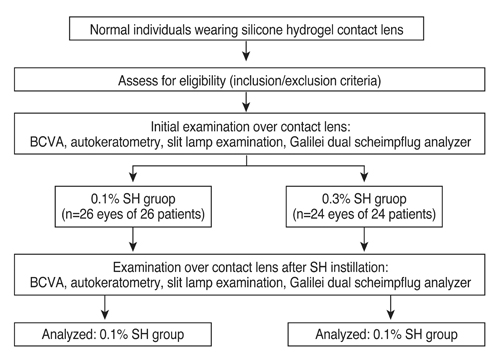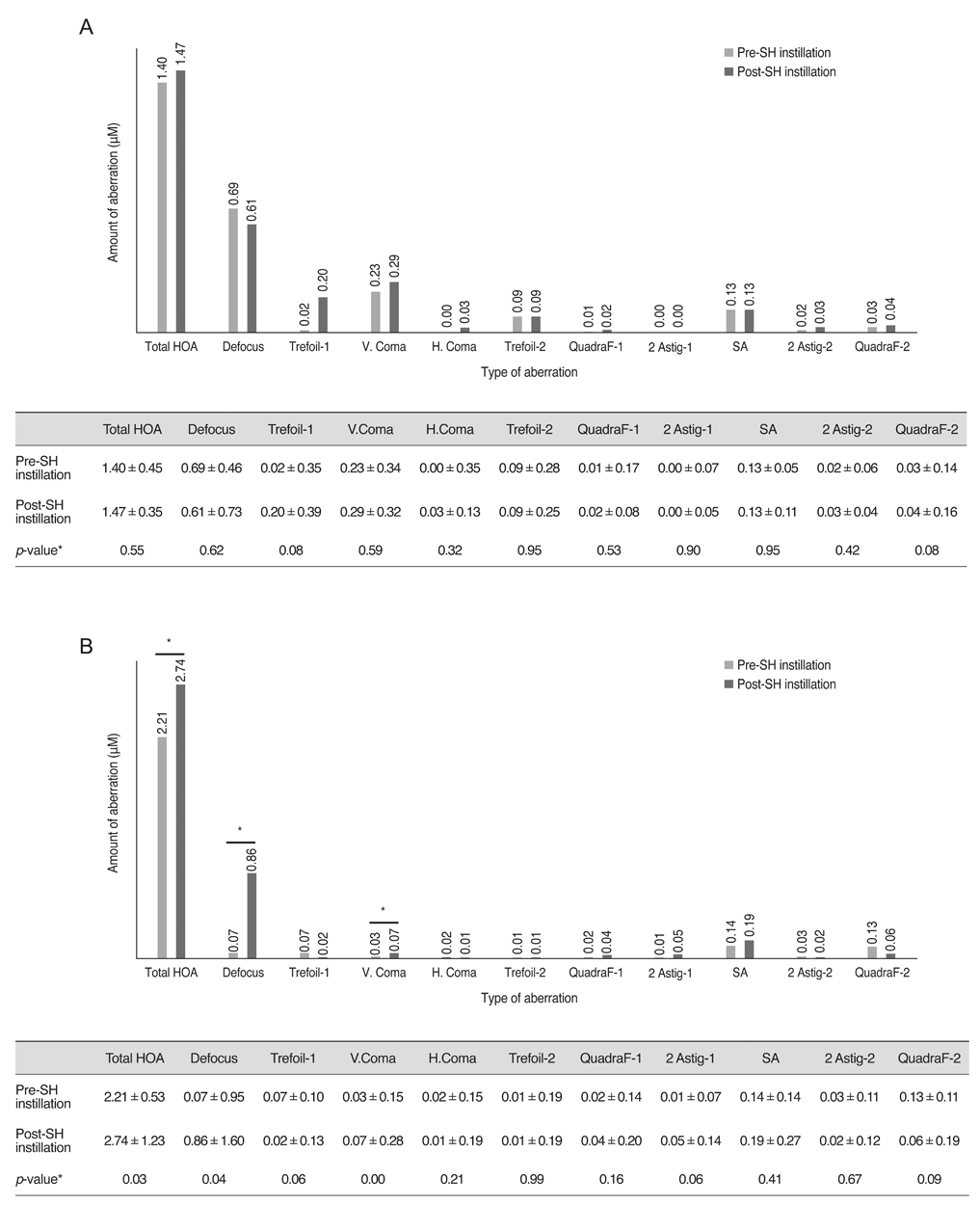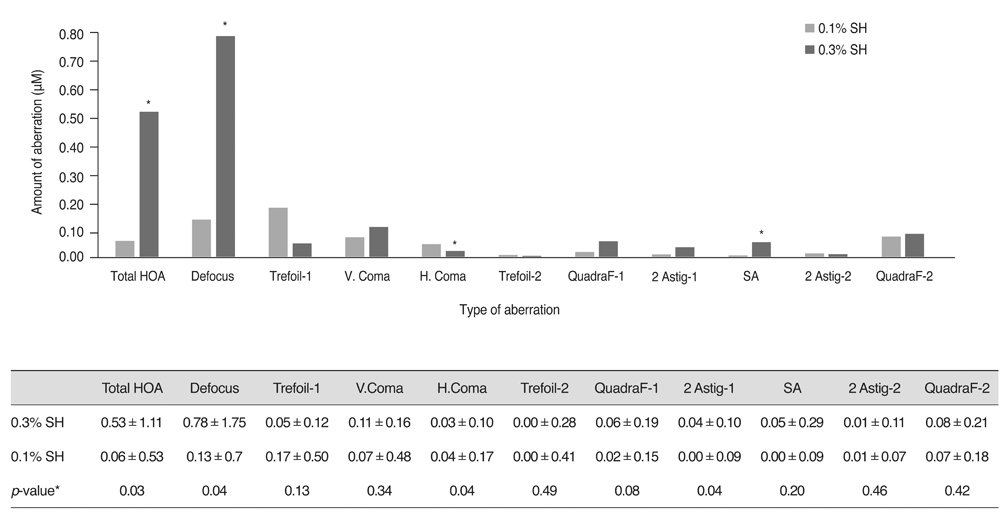Korean J Ophthalmol.
2018 Apr;32(2):89-94. 10.3341/kjo.2017.0099.
Influence of Sodium Hyaluronate Concentration on Corneal Aberrations in Soft Contact Lens Wearers
- Affiliations
-
- 1Department of Ophthalmology, Pusan National University Hospital, Pusan National University School of Medicine and Medical Research Institute, Yangsan, Korea.
- 2Department of Ophthalmology, Gyeongsang National University Changwon Hospital, Gyeongsang National University School of Medicine, Changwon, Korea. loveis293@naver.com
- KMID: 2408947
- DOI: http://doi.org/10.3341/kjo.2017.0099
Abstract
- PURPOSE
This study aimed to evaluate the influence of varying concentrations of sodium hyaluronate (SH) eye drops on corneal aberrations in normal individuals wearing silicone hydrogel contact lenses.
METHODS
Normal individuals wearing silicone hydrogel contact lenses were enrolled in this study. Subjects were classified into two groups depending on the concentration of the preservative-free SH used (group 1, 0.1% SH; group 2, 0.3% SH). All subjects were asked to blink five times after instillation of the SH eye drop and before the Galilei measurements. Corneal aberrations were measured over the contact lenses before and after SH eye drop instillation. Visual acuity (VA) over the contact lenses was also measured both before instillation of the SH eye drop and after the subjects completed the five blinks.
RESULTS
There was no change in VA after SH instillation in group 1; however, group 2"²s VA significantly deteriorated after SH instillation. Changes in VA after SH instillation compared to baseline were significantly higher in group 2 than in group 1. Similarly, the increase in corneal aberrations after SH instillation was significant in group 2 but not significant in group 1. Among the significantly increased corneal aberration parameters, defocus was the main type in group 2. Changes in corneal aberrations after SH instillation compared to baseline were significantly higher in group 2 than in group 1.
CONCLUSIONS
A 0.3%-concentration of SH increases corneal aberration and decreases VA in soft contact lens wearers. Defocus is the main type of aberration that increased in the 0.3% SH instillation group.
MeSH Terms
Figure
Reference
-
1. Glasson MJ, Stapleton F, Keay L, Willcox MD. The effect of short term contact lens wear on the tear film and ocular surface characteristics of tolerant and intolerant wearers. Cont Lens Anterior Eye. 2006; 29:41–47.
Article2. Caffery BE, Richter D, Simpson T, et al. CANDEES: the Canadian Dry Eye Epidemiology Study. Adv Exp Med Biol. 1998; 438:805–806.3. Young G, Veys J, Pritchard N, Coleman S. A multi-centre study of lapsed contact lens wearers. Ophthalmic Physiol Opt. 2002; 22:516–527.
Article4. Dumbleton K, Woods C, Fonn D. An investigation of the efficacy of a novel ocular lubricant. Eye Contact Lens. 2009; 35:149–155.
Article5. Begley CG, Caffery B, Nichols KK, Chalmers R. Responses of contact lens wearers to a dry eye survey. Optom Vis Sci. 2000; 77:40–46.
Article6. Subbaraman LN, Bayer S, Glasier MA, et al. Rewetting drops containing surface active agents improve the clinical performance of silicone hydrogel contact lenses. Optom Vis Sci. 2006; 83:143–151.
Article7. Chalmers RL, Begley CG. Dryness symptoms among an unselected clinical population with and without contact lens wear. Cont Lens Anterior Eye. 2006; 29:25–30.
Article8. Nichols JJ, Ziegler C, Mitchell GL, Nichols KK. Self-reported dry eye disease across refractive modalities. Invest Ophthalmol Vis Sci. 2005; 46:1911–1914.
Article9. Johnson ME, Murphy PJ, Boulton M. Effectiveness of sodium hyaluronate eyedrops in the treatment of dry eye. Graefes Arch Clin Exp Ophthalmol. 2006; 244:109–112.
Article10. Hamano T, Horimoto K, Lee M, Komemushi S. Sodium hyaluronate eyedrops enhance tear film stability. Jpn J Ophthalmol. 1996; 40:62–65.11. Shimmura S, Ono M, Shinozaki K, et al. Sodium hyaluronate eyedrops in the treatment of dry eyes. Br J Ophthalmol. 1995; 79:1007–1011.
Article12. Koh S, Maeda N, Ikeda C, et al. Effect of instillation of eyedrops for dry eye on optical quality. Invest Ophthalmol Vis Sci. 2013; 54:4927–4933.
Article13. Snibson GR, Greaves JL, Soper ND, et al. Precorneal residence times of sodium hyaluronate solutions studied by quantitative gamma scintigraphy. Eye (Lond). 1990; 4(Pt 4):594–602.
Article14. Johnston PR, Rodriguez J, Lane KJ, et al. The interblink interval in normal and dry eye subjects. Clin Ophthalmol. 2013; 7:253–259.
Article
- Full Text Links
- Actions
-
Cited
- CITED
-
- Close
- Share
- Similar articles
-
- The Lysozymal Concentration in Tear Film of Contact Lens Us ers
- Clinical Features of Corneal Erosion in Contact Lens Wearers
- The Long-Term Effects of Soft Contact Lens Wear on Corneal Thickness, Curvature and Endothelium
- Corneal Complications in Contact Lens Wearer
- Effect of Aging and Soft Contact Lens Wearing on the Change of Corneal Endothelial Cells





